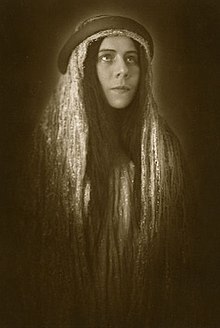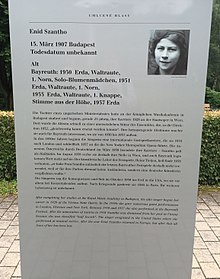Enid Szánthó

Enid Szánthó ( March 15, 1907 in Budapest - [?] 1997 [ date of burial: April 21, 1997, London]) was a Hungarian opera singer with an alto voice . She belonged to the ensemble of the Vienna State Opera from 1928 and made guest appearances in Florence, London, Berlin, Paris and New York as well as at the Bayreuth Festival . Her career was de facto ended after the annexation of Austria .
life and work
Enid Szánthó was the daughter of a Hungarian ministerial councilor. She studied singing at the Royal Hungarian Music Academy in Budapest and graduated with a diploma. One of her teachers was the Austro-Hungarian opera singer and vocal teacher Laura Hilgermann . At the age of 21 she was already engaged as a member of the ensemble at the Vienna State Opera , where she was one of the top ranks of the house from the first year and appeared in numerous premieres. For example, she was represented on all four evenings of the cycle Der Ring des Nibelungen , newly staged by Lothar Wallerstein , in Rheingold from 1928 as Erda, in Die Walküre from 1930 as Schwertleite, in Siegfried from 1931 as Erda and in the Götterdämmerung , also 1931, as First Norn and Flosshilde. The sets for this production, which put the passions between the main characters in the foreground and not the ethnic aspect, came from Alfred Roller and Robert Kautsky . The conductors were Wilhelm Furtwängler and Clemens Krauss .
Also in 1928 the singer made her debut at the Salzburg Festival as the third boy in Mozart's Magic Flute , staged by Lothar Wallenstein and conducted by Franz Schalk . At the Vienna State Opera she quickly took on central alto roles in Verdi operas (Azucena in 1930, Ulrica and Giovanna in 1932), but she was able to establish herself as the first person in the Wagnerian field even faster. She quickly became a pillar of the Viennese ensemble, which "could hardly be replaced on an equal footing", according to the management as early as 1932. As early as 1930 she made her debut in Ring des Nibelungen and Parsifal at the Bayreuth Festival , as Erda, Waltraute, Erste Norn and flower girls. In the following years she was invited to Bayreuth again on a regular basis. Countess Tilly took it over in the highly acclaimed premiere - The Violet by Julius Bittner on December 8, 1934 in the Vienna State Opera. It staged Lothar Wallerstein , it conducted Clemens Krauss . Richard Mayr sang the main male role .
The international career began in 1935. She was successful as a concert soloist at the Maggio musicale in Florence and on a concert tour in North America, subsequently also sang in Berlin and Paris, made her first guest appearance in 1936 at the Royal Opera House Covent Garden in London as Erda and Fricka, and made her debut in the 1937 season / 38 at the Metropolitan Opera in New York, as Fricka, Brangäne and Klytämnestra.
In 1938 her career broke. She was no longer invited to Bayreuth. Heinz Tietjen , artistic director of the festival, subsequently stated that he had "not wanted to hire a foreigner this time", but rather a German artist. This was the official version. In reality, from 1938 the National Socialists considered her to be half-Jewish . After the annexation of Austria , she also lost her engagement at the Vienna State Opera. Presumably her last performance in Vienna was on June 27, 1938, the tragic role of the gypsy Azucena in Verdi's troubadour .
She fled to the United States . Although there were a few appearances at the New York Met afterwards and a guest performance in Paris after the fall of the Nazi regime, the artist could no longer find a permanent place of work. She earned her living as a singing teacher in Michigan and New York, and occasionally gave concerts in schools and libraries. In the fall of 1945 she could be seen in four opera and operetta productions of the New York City Opera on Broadway , as Mary in the Flying Dutchman , Czipra in the Gypsy Baron , Martha in Faust and Ludmilla in the Bartered Bride . After 1946 there are no more traces.
rank
Enid Szánthó was one of the world's best contralto players of her time, especially in the dramatic roles of Strauss, Verdi and Wagner. Her expressive, dramatic alto voice was widely praised.
repertoire
Opera (selection)
The list of roles was created on the basis of the Vienna State Opera's online archive, which is not complete until 1955.
|
Kienzl :
Giordano :
Puccini :
Smetana :
|
Verdi :
Wagner :
Weber :
|
concert
The artist was also valued as a concert and oratorio altist with an extensive repertoire. This ranged from the alto solo in Bach's St. Matthew Passion to the present day. For example, she took over the alto solos in Mahler's Third , conducted by Eugen Szenkar in Vienna in 1933 , and in the world premiere of the oratorio The Book with Seven Sieges by Franz Schmidt on June 15, 1938, also in Vienna. The world premiere was conducted by Oswald Kabasta , and Johannes sang by Rudolf Gerlach-Rusnak .
Her song repertoire is particularly guaranteed from performances in the USA. At a concert at Ann Arbor High School in Michigan in 1941 she sang three songs by Franz Schubert , An die Musik , Liebesbotschaft and the Erlkönig , as well as the Kindertotenlieder by Gustav Mahler . At another concert in Ann Arbor , Enid Szánthó performed four songs by Hugo Wolf and the last two Wesendonck songs by Richard Wagner. At the New York Public Library she interpreted works by her compatriot Béla Bartók .
Audio documents
- The voice of Enid Szánthó is documented in several recordings of performances by the Vienna State Opera, for example in the Walküre from March 1, 1933 as a sword lead. The Rhine daughters scene from Rheingold was published on Koch / Schwann , with Luise Helletsgruber , Dora With and Hermann Wiedemann as Alberich. On this stamp, the singer can also be heard as Erda and Magdalene in the Meistersinger von Nürnberg .
- There are private recordings of the singer's voice from the Metropolitan Opera , for example on Rococo excerpts from Tristan and Isolde with Kirsten Flagstad in the female title role and on Unique Opera Records her creation of Klytämnestra in Richard Strauss' Elektra .
- In 1939 she recorded Tristan und Isolde with the New York Philharmonic under the direction of Sir John Barbirolli and with Kirsten Flagstad as partner . Her composition of the aria of Brangäne from the second act, Lonely Waking in the Night, deserves special attention .
- 1945/46, the conductor played Eugene Ormandy with the Philadelphia Orchestra and the Westminster Choir , the Ninth one of Beethoven. The soloists were Stella Roman (soprano), Enid Szánthó (alto), Frederick Jagel (tenor) and Nicola Moscona (bass).
Commemoration
In the park near the Bayreuth Festival Hall , a memorial plaque with a text from the book Silent Voices was erected.
Individual evidence
- ↑ UK, Burial and Cremation Index, 1576–2014 Enid Szantho-Stenzer , accessed June 1, 2020
- ↑ In 1946 she sang Mary in Wagner's Fliegendem Holländer at the Paris Opéra-Comique with the ensemble of the City Center Opera New York .
- ↑ Concerts at a high school in Michigan and at the New York Public Library are guaranteed . See Virgil Thomson: Virgil Thomson: Music Chronicles 1940-1954 (LOA # 258) , Library of America 2014
- ↑ Spotlight on Broadway: Enid Szantho, Performer , accessed March 11, 2019
- ^ Wiener Staatsoper : Search result: Performances with Enid Szánto , accessed on March 10, 2019
- ↑ Elisabeth Bauchhenß: Eugen Szenkar (1891–1977): A Hungarian-Jewish conductor writes German opera history , Böhlau Verlag Köln Weimar 2016, p. 142
- ^ School of Music, Theater & Dance Programs , University of Michigan School of Music 1939, pp. 35 and 37
Web links
- You Tube: Tristan and Isolde , audio sample in the role of Brangäne with the aria Lonely waking in the night from the second act of the opera
- Isolde's love death , short biography with photographs
- Enid Szánthó in the Bavarian Musicians' Lexicon Online (BMLO)
- OPERALXICON , short biography ( hungarian )
| personal data | |
|---|---|
| SURNAME | Szánthó, Enid |
| BRIEF DESCRIPTION | Hungarian opera singer (alto) |
| DATE OF BIRTH | March 15, 1907 |
| PLACE OF BIRTH | Budapest |
| DATE OF DEATH | 1997 |
